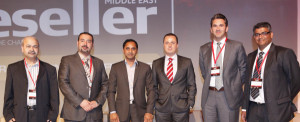Fabrizio Croce, Regional Director, Southern Europe and Middle East, WatchGuard discusses the importance of guarding encrypted traffic, and offers his predictions for 2015.


Fabrizio Croce, Regional Director, Southern Europe and Middle East, WatchGuard discusses the importance of guarding encrypted traffic, and offers his predictions for 2015.

IT security professionals have to find frailties in external security systems before cybercriminals – who can attack at an increasingly fast pace – seek to exploit them. With that in mind, it is paramount that security professionals are aware of common weak points.

Charged with supporting a network of four institutions at Gulf Medical University and their teaching hospitals, Thumbay Group looked to Huawei to implement a LAN that could provide high bandwidth for the transfer of vital patient information.

Storing data in the public cloud can be both convenient and cost-effective. Vendors can do some things to ensure security, but is data stored on the public cloud ever truly safe? CNME investigates the benefits and pitfalls to storing data on the public cloud.

Gartner has released its predictions for the top 10 technology trends that will be strategic for most organisations in 2015. …
Network security appliance provider Cyberoam has launched its Unified Threat Management appliance CR10iNG.

Organisations in the Middle East acknowledge the importance of tightening security controls, but a majority fail to secure privileged passwords. V Balasubramanian, Marketing Manager, IT Security, ManageEngine, discusses results of a study conducted by ManageEngine at GITEX Technology Week 2014.

Digital protection firm ESET has announced that it plans to unveil Smart Security 8 and NOD32 Antivirus 8, the latest versions in its line of security solutions at GITEX Technology Week 2014.

Unified Communications in the cloud is finding more takers in the region as it offers cost benefits, flexibility and agility to users

Brian Kenyon, Chief Technology Strategist, McAfee, a part of Intel Security, follows a “define-freeze-fix” approach to eradicate malware, and is confident that his company is well positioned to deal with today’s ever-evolving threat landscape.
Ramkumar B, President, Value Division, Redington Gulf, discusses the company’s plans for cloud and other focus areas for driving the business.
Cyberoam has appointed Burhan Technology as their platinum partner for Kuwait.

Intensified competition coupled with declining voice ARPU is forcing telecom service providers to look around for new revenue streams that some of the new advanced technologies offer. However, it can be a daunting task for carriers who are saddled with legacy systems and manual internal processes.

Reseller Middle East’s fifth annual Partner Excellence Conference rallied together the channel community to discuss emerging market trends and evolving business operations.

CNME sat down with Ahmed Salman Al-Sulaiti, Chief Technology Officer, Qatar National Broadband Network to find out how the firm plans to improve the nation’s broadband speeds in line with the Qatar National Vision 2030.

Gartner has highlighted its top 10 technologies for information security and their implications for security organisations in 2014.

Between 29th April and 27th May, FireEye Labs identified several new Molerats attacks targeting at least one major U.S. financial institution and multiple European government organisations.

Two months ago the tech world was hit with the revelation that hundreds of thousands of websites were vulnerable to a critical bug, forcing us to change our passwords on all our favourite sites immediately.

Anthony Perridge, EMEA Channel Director, Sourcefire, now a part of Cisco, discusses the importance of protecting data centres.
Premchand Kurup, Chief Executive Officer, Paramount, shares trends in information security and how it impacts the systems integrator’s business.